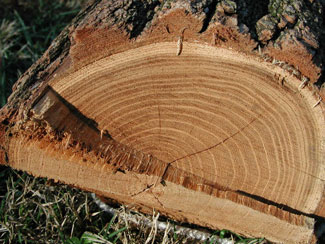Resource Library
Plant of the Week: Tree Rings
The University of Arkansas System Division of Agriculture does not promote, support or recommend plants featured in "Plant of the Week." Please consult your local Extension office for plants suitable for your region.
Plant of the Week
Tree Rings

The old gardener’s quote tells us that the best time to plant a tree was 20 years ago; the second best time is today. As a society we are an impatient lot and want things to happen quickly but some things – like trees growing large and beautiful – just take time. Growth rates vary considerably amongst tree species but even within a species, the rate of growth is modified by rainfall, temperature and competition by neighboring trees. Annual growth rings tell us not only how old the tree was when it died but also the story of the travails it endured during its lifetime.
Tree rings form in the trunk of a tree from new cells generated in the cambium, the meristem (growing point) that lies just beneath the tree’s bark. In the early part of the growing season when the tree is emerging from dormancy and growing conditions are near perfect cells grow rapidly and are less dense. Later in the growing season when heat and drought conditions become more prevalent, cell growth slows down and the wood becomes more dense. The light colored, less dense part of the ring is called “early wood” while the darker, denser portion of the annual ring is called “late wood.” The oldest wood in the tree is in the center of the tree, the youngest just below the bark.
In temperate regions these rings are almost always correlated to the passage of a single growing season. In a few cases it has been shown that a tree can sometimes make two growth rings in a season if conditions are very dry in the early part of the year followed by heavy rains in the summer and a late fall. In 1816, dubbed the “year without a summer” because of the eruption of Mount Tambora in Indonesia, many oaks in the northern hemisphere did not produce a discernible annual growth ring at all.
If you study the stump of a cut tree you usually notice that the first three to five years of life the rings are close together and difficult to discern. Most of us have noticed this with trees we have planted. The first year or two they just sit there frustrating our wishes for them to grow. However, after this establishment period when the roots are anchoring into the soil, the tree begins to grow rapidly. During these early years it is not unusual for trees to increase their girth by a half-inch or more per year. his rapid growth rate continues – but always moderated by the prevailing moisture conditions of a particular season – for 10 to 20 years until the tree passes from the juvenile stage of growth into the adult phase when it begins flowering as producing fruit.
The length of juvenility varies with species. A few precocious species such as redbuds and flowering pears flower in three to five years from seed but more commonly it takes a decade for dogwoods to bloom and 15 to 20 years for many oaks and pines. When a tree reaches adulthood it begins diverting carbohydrates into flowers and seed production, and not surprisingly, the size of the annual growth ring is reduced accordingly. Trees will sometimes fool you though when there is a sudden reduction in tree-to-tree completion. For example, when a woodlot is cut over and the largest trees removed or a housing development is created and weak and/or undesirable species culled, the remaining trees will make a spurt of growth with correspondingly wider growth rings.
Growing conditions though are the ultimate arbiter of how wide or how narrow an annual growth ring will be. You don’t have to be an experienced dendrochronologist -- one who studies tree rings to either date the age of some wooden artifact or to study climate change -- to discern the nearly decade long drought of the 1930s writ large (well, small) on the trunk of a century-old oak.
Studying the tree rings of a tree that has recently died usually reveals that its death was not sudden and unexpected. Usually the growth rings of a dying tree will start getting narrower about five years before the tree finally gives up and dies. Oftentimes you can remember back about what happened in or around the tree that triggered its downturn and ultimate demise.
By: Gerald Klingaman, retired
Retired Extension Horticulturist - Ornamentals
Extension News - April 12, 2013
The University of Arkansas System Division of Agriculture does not maintain lists of retail outlets where these plants can be purchased. Please check your local nursery or other retail outlets to ask about the availability of these plants for your growing area.